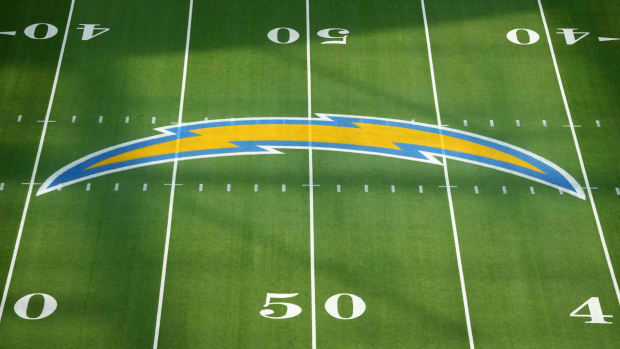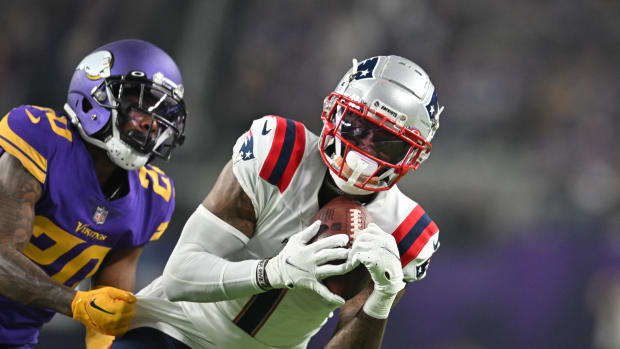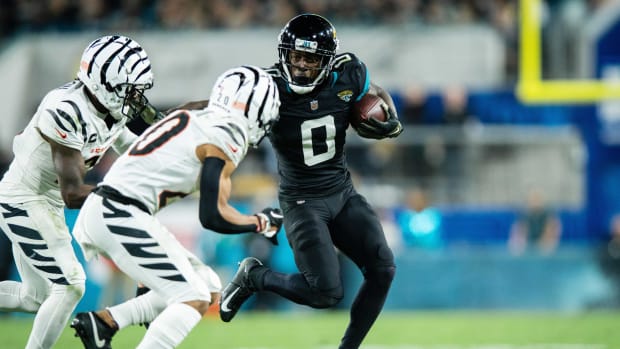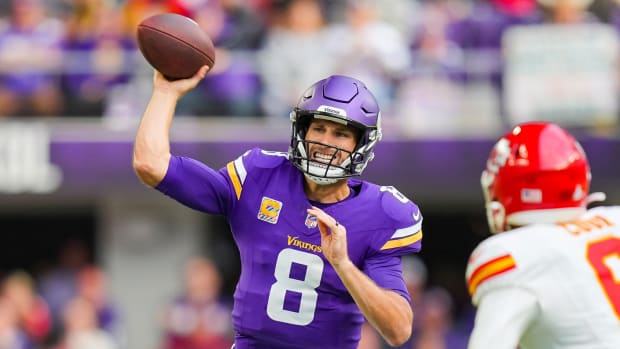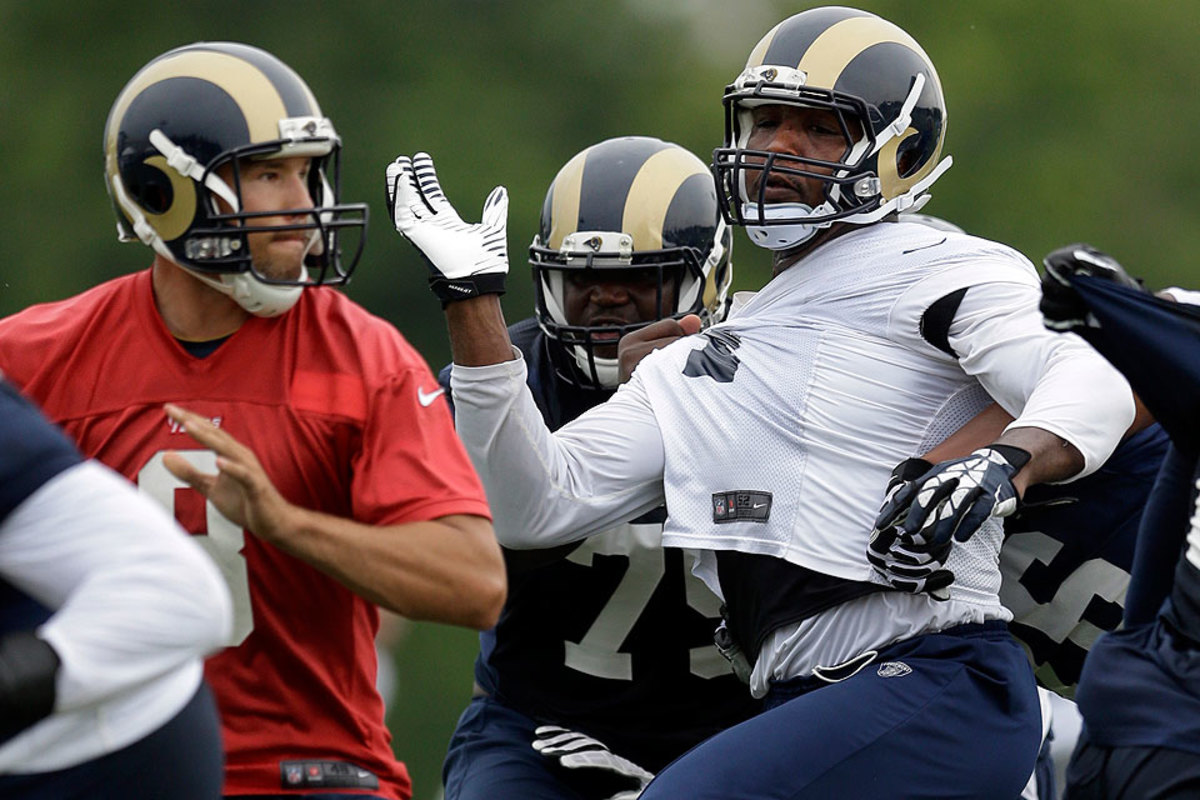
Rams Preview: Defense Might Not Be Enough
OFFENSE
What, exactly, are the Rams trying to be? Right now, they’re a team with an identity crisis. Last year, head coach Jeff Fisher and GM Les Snead used the eighth overall pick on Tavon Austin and signed free agent flex tight end Jared Cook for a $16 million signing bonus. Both moves were significant investments in a quick-striking spread offense—like the one quarterback Sam Bradford thrived in at Oklahoma.
But Bradford and his receivers struggled mightily in a spread scheme out of the gates last year. To alleviate the pressure, offensive coordinator Brian Schottenheimer incorporated more basic, run-oriented—even smash mouth—concepts in Weeks 5 and 6. The adjustment worked.
Then Bradford tore his ACL in Week 7 and, with backup Kellen Clemens at the helm and needing to be hidden, the adjustment became permanent. Aside from a few 3 x 2 sets in passing situations, the Rams abandoned an aerial attack that too often was restricted to underneath targets anyway (the quarterbacks’ fault, not the play-caller’s). They committed to a ball control approach, led by fifth-round rookie running back Zac Stacy.
One might have chalked this up to the Rams just making due with the resources they had. But this past offseason, with everyone healthy, Fisher and Snead used the second overall pick on Greg Robinson. If you’re a spread offense that gets the ball out quickly and in space, it doesn’t make sense to invest heavily in a mauling offensive lineman, especially if you already have a good (and pricey) veteran left tackle like Jake Long. This sort of investment would, however, make sense if you’re a grinding offense that wants to keep running “power” and “counter” inside, like the Rams did a year ago. But in this case, where does last year’s first-rounder fit? The Robinson selection almost directly contradicts the Austin selection. There’s a role somewhere for Austin in a traditional black and blue offense, but it’s miniscule and hard to pinpoint. Austin is a guy who needs to be on the move and given the ball in space. This is hard to do out of traditional two-back, run-type sets. In those, you feature more play-action passes and isolation routes on the outside, requiring receivers to create their own separation off the line. That’s very difficult for the 5-8, 175-pound Austin.
Tavon Austin needs to be on the move and given the ball in space, which is hard to do out of traditional two-back, run-type sets. (Jeff Roberson/AP)
Separating from man coverage was actually difficult for this entire receiving corps last season. That won’t suddenly change in 2014, so Schottenheimer is going to have to incorporate more intertwined man-beater concepts like the ones he ran with the low-octane Jets a few years ago. He at least has a deep cast, though it’s one that’s bereft of clear-cut starters. Austin Pettis is Bradford’s security blanket, but the lanky fourth-year pro is not quite a playmaker. The speedy, long-striding Chris Givens can make plays but is constricted by unrefined route running. Brian Quick, a second-round pick in 2012, needs to be used more, but that can’t happen if he fails to haul in catchable balls or stays too upright in running downfield routes. Last year’s third-round pick, Stedman Bailey, has made slow progress in carving out a niche; a four-game suspension to begin the season won’t help. And newcomer Kenny Britt, because of knee problems, is a shell of his former self.
Schottenheimer also has Jared Cook at tight end. Cook is at his best in spread sets where he can detach from the formation and draw matchups against linebackers. In a power running system, he is asked to play more along the line of scrimmage, where his blocking is very inconsistent. Joining Cook is move-oriented tight end Lance Kendricks plus H-back Cory Harkey, who was a stalwart lead-blocker for Stacy last season.
The drafting of running back Tre Mason in Round 3 was similar to the Robinson pick in that it suggests a commitment to a power running offense. Though built like Giovani Bernard at 5-8, 205 pounds, Mason has the potential to be a foundational type back, capable of ramming the ball inside. The Rams won’t ask him to do that fulltime, though, at least not right away. Most likely, Mason will complement Stacy, who could be difficult to take off the field. Stacy’s 3.9 yards per carry last season doesn’t look impressive on paper, but the low average was partly a function of how a power running offense operates. On film, Stacy was intriguing, showing lateral agility and quick feet in confined areas and having the downhill momentum to keep moving forward on contact.
Stacy and Mason will be working behind Robinson, a future tackle who is transitioning into the NFL at left guard. Robinson couldn’t ask for a better player to learn alongside than Jake Long, who stood out as a run-blocker and pass protector last season before tearing his ACL and MCL two days before Christmas. The seventh-year veteran is said to be fully recovered. To Robinson’s right is 11th-year center Scott Wells, creating a sandwich of veteran wisdom around the rookie. On the right side, tackle Joe Barksdale lacks the athleticism to hold up in pass protection, but the Rams are content to gamble with him because they want Rodger Saffold to play guard. When he wasn’t hurt, Saffold flashed in the running game last year. The Rams did make provisions in case he has to slide back to right tackle, signing Davin Joseph, a former Pro Bowl guard in Tampa Bay whose career has been derailed by injuries.
Conducting this show is Bradford, whom the Rams insist is Their Guy. Though Bradford has two years remaining on a rookie deal that’s keeping his cap number in the mid teens (very reasonable for a starting QB), this is a make-or-break year for him. Injuries were a problem coming out of Oklahoma, and that’s remained the case in the pros (torn ACL last year, ankle injury two years before that).
What system the Rams ultimately run this year largely will be a function of what Bradford is most comfortable with. He has the arm strength and pinpoint accuracy to prosper in any scheme. His problem has been a lack of pocket poise coupled with tunnel vision. There have been too many instances where he gets impatient and doesn’t see the entire field. Those are crippling weaknesses for an NFL quarterback.
The Rams don’t need Bradford to be a superstar. In fact, they quietly went 4-3 without him down the stretch, with wins over the Colts, Saints and playoff-contending Bears. But they do need Bradford to become dependable. Otherwise they’ll have to ask too much of their potentially spectacular defense.
DEFENSE
What makes this unit potentially spectacular is a defensive line that, heading into the draft, may have already been the best in football. It certainly was coming out of it, as the Rams were pleasantly surprised to find defensive tackle Aaron Donald still on the board when picking again at 13. With that selection, this officially became the NFL’s only D-line to boast four former first-round picks.
In order to reach their full potential on defense, the Rams need linebacker James Laurinaitis and Alec Ogletree to play better against the run. (Jeff Roberson/AP)
Donald will work alongside Michael Brockers (drafted 14th overall in 2012) and ahead of two outstanding backups, Kendall Langford and Eugene Sims (who can also play defensive end). Tremendously strong hands and a burst off contact make Brockers one of the most thunderous block-shedders in the game. It helps that he faces a lot of one-on-one scenarios playing alongside Robert Quinn (14th in 2011). Quinn is far and away the most terrifying edge-rusher in the game right now. Opposite him is Chris Long (second overall in 2008), whose speed and quickness have gradually climbed from average to solid to impressive over his career.
Last year’s defensive coordinator Tim Walton did an excellent job at creating one-on-one opportunities for his pass rushers through a variety of different fronts. Two prominent wrinkles were having Quinn align inside, where he was equally as explosive, and using two three-techniques on passing downs, which compromises a lot of an offensive line’s double-team concepts and is a great way to set up stunts.
Walton, unfortunately, did not excel in other areas and got replaced this past offseason by Gregg Williams, whom Fisher had originally hired upon arriving in St. Louis two years ago, just prior to Williams’s Bountygate suspension. Williams’s scheme will be similar to Walton’s in pass-rushing alignments and the zone-based coverage concepts that Fisher likes. What’ll be different are the wrinkles of aggression, something Williams typically applies on blitzes. But with such a lethal front, he will now apply more to coverage disguises and rotations.
The question is whether St. Louis’s young back seven can handle this. Middle linebacker James Laurinaitis has evolved into a savvy vet, but there’s little evidence that he can carry a unit Ray Lewis-style. It’s disconcerting that, even with a domineering front four, the Rams last season were gouged repeatedly on the ground, especially by zone rushing attacks. While the safety run support was never great, there has to be some blame on Laurinaitis’s linebacking unit.
Working alongside Laurinaitis is the back seven defender with the most to learn but also the one with the most upside: Alec Ogletree. The second-year pro has rare speed and fluidity but must figure out how to recognize even basic NFL offensive designs. Physically, Ogletree is clearly this defense’s most versatile chess piece; it will be fascinating to see how Williams uses him.
In the secondary are third-year corners Janoris Jenkins and Trumaine Johnson, both of whom had first-round talent entering the NFL but respectively fell to Rounds 2 and 3 because of character concerns. Jenkins has playmaking prowess as long as his confidence does not waiver. Johnson has shown the ability to transition from zone to man coverage on the outside, which is vital for excelling in a single-high safety base defense.
To rectify the team’s problems in nickel, Fisher and Snead drafted Lamarcus Joyner in the second round. The 5-8, 185-pounder can fill the slot and, based on his experience at Florida State, has the potential to drop back to safety in the base 4-3 (a la Tyrann Mathieu in Arizona). In that case he’d be supplanting free safety Rodney McLeod, who has also played the slot in certain sub-packages. At strong safety is T.J. McDonald, a straight-line athlete who covers ground quickly thanks to his length. To back up—or maybe eventually challenge—McDonald, the Rams used a fourth-round pick on hard-hitting converted linebacker Mo Alexander.
SPECIAL TEAMS
After going 7 of 13 on 50-plus-yard field goals in 2012, Greg Zuerlein was asked to kick from that deep just twice last year (he made one). Punter Johnny Hekker set an NFL record with a 44.2 net average. In the return game, Tavon Austin was up and down as a rookie but found his lethal rhythm as the season progressed.
BOTTOM LINE
If the Rams played in the NFC East, they’d be a dark horse contender because of their defense. But unfortunately they’re in the loaded NFC West, where San Francisco and Seattle have even better defenses plus and—here’s the real separation—the offenses to go along with it.




































